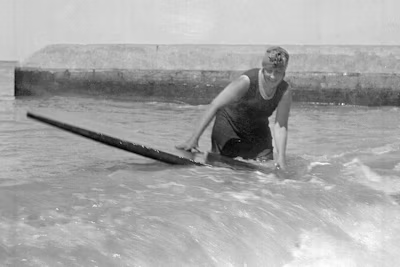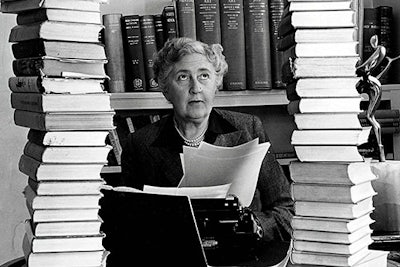
About Agatha Christie
Writer, Traveller, Playwright, Wife, Mother, Surfer

Born in Torquay in 1890, Agatha Christie became, and remains, the best-selling novelist of all time.
She is best known for her 66 detective novels and 14 short story collections, as well as the world’s longest-running play – The Mousetrap. Her books have sold over a billion copies in the English language and a billion in translation.
Image © The Christie Archive Trust
What can I say at seventy-five? ‘Thank God for my good life, and for all the love that has been given to me.
Christie's Life

The Early Years
Agatha Mary Clarissa Miller was born on 15th September 1890. Her father was a wealthy American man called Frederick Miller, and her mother was Clara, the Irish niece of Frederick’s father’s second wife.
Frederick and Clara had finally settled in Torquay, a popular resort on the South Devon coast, and baby Agatha came along as a “much-loved afterthought”, ten years after her brother Monty, and eleven after her sister Madge. The family lived a comfortably well-off existence at Ashfield, a large home not far from the sea with a big garden and plenty of places for little girls to play.
Image © The Christie Archive Trust
Discover more about Agatha Christie

Christie's favourite Christie
Read more about the Queen of Crime and discover which stories were her favourites.

How Christie wrote
Overheard conversations, notebooks and Dictaphones: read the secrets of Agatha Christie’s writing career.

Christie's Wallingford
Discover Agatha Christie's Wallingford, the location of Winterbrook House which was the home of Agatha and Max Mallowan
About Agatha Christie's Travels

Childhood and Adolescence Overseas
When Agatha was five or six, her family’s difficult financial situation drove them to the more economical solution of renting out their Torquay home and spending time in various hotels in France. They stayed in the Pyrenees, Paris and Brittany, all of which proved formative for the young girl.
“The two winters and one summer that I spent in Paris were some of the happiest days I have ever known. All sorts of delightful things happened all the time.” An Autobiography
Agatha Christie in Paris, c1906/7 Image © The Christie Archive Trust
Family Memories

Introducing Nima
Agatha Christie’s grandson Mathew Prichard shares insights about his grandmother’s life and stories.

The Guessing Game
Mathew recalls a memory of Agatha Christie reading the family A Pocket Full of Rye and everyone guessing who the murderer was.
Download the Agatha Christie reading list
Buy books about Agatha Christie

Agatha Christie: An Autobiography
Paperback
From early childhood at the end of the 19th century, through two marriages and two World Wars, and her experiences both as a writer and on archaeological expeditions with her second husband, Max Mallowan, this book reveals the true genius of her legendary success with real passion and openness.


 UK
UK 










